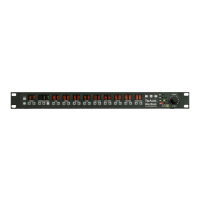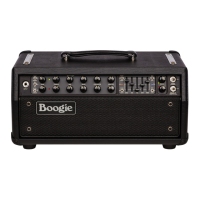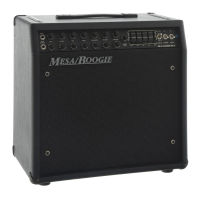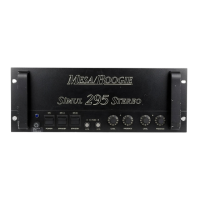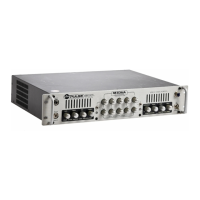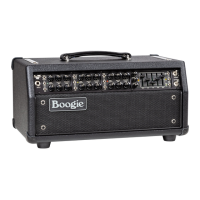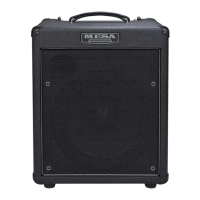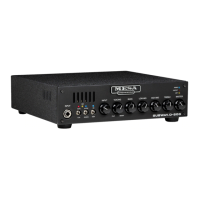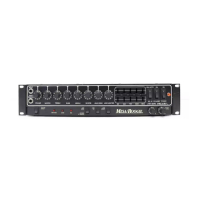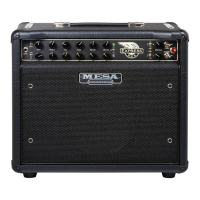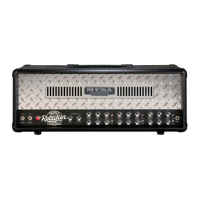PRESENCE
This control adjusts high frequencies - above those of the TREBLE - and is farther downstream in the signal path
than the Tone Controls at the end of the preamp. Unlike a PRESENCE circuit located in the power section, the TC-50 utilizes a preamp
roll-off type PRESENCE to maintain a level of urgency and simplicity in the power section for tonal reasons. This is part of its urgent
character and ability to hit so hard in the midrange frequencies.
You can think of the PRESENCE as a control that allows you to either clamp the highs down, compressing and darkening things - or
open it up and let the full spectrum of upper harmonics come blazing through. It also has a great deal to do with how dynamic the
signal is and how a sound will cut through the mix in an ensemble environment.
At low settings (7:30 – 10:30) the sound will be warm and round with a more compressed feel and dynamic fluctuation will be limited.
As the PRESENCE is increased (11:00 – 2:30), the top end starts to become more dominant and that compression gives way to “cut”
and dynamic peaks jump out with startling speed and accuracy. At the top end of the control (2:30 – 5:30), a super aggressive blend
of upper harmonics dominate the sound and this region can be somewhat dangerous if it’s not applied in small measures. Higher
notes will slice and dice even the bravest set of ears and we suggest using this region mostly in the studio for recording heavy crunch
rhythm parts and even then – mostly on parts that feature the lower strings. This region – especially when coupled with the inherent
curve of many of the microphones typically used in P.A. (sound reinforcement) applications can be truly punishing.
Clean sounds in Channel 1 can generally benefit from a bit higher settings (10:30 – 12:30) than sounds in this or any Channel that
has overdrive involved in its makeup. Once saturation begins the frequencies carried in the PRESENCE control can make things
edgy or brittle… even buzzy, real fast if you aren’t careful. Overdriven chording sounds can tolerate higher settings (10:30 – 12:30)
better than can single note sounds, which usually want to roam the zone below 11:00 to stay round, focused and vocal.
TREBLE
While the GAIN is the most powerful control in the TC-50, the TREBLE comes in a close second. The TREBLE is
responsible for shaping the character of the entire Channel. It can overpower the rest of the Tone controls easily and therefore its
setting is crucial to a rich and balanced sound in all three Channels. Setting the TREBLE with care and taste in mind is critical for the
Tone control string to work in harmony.
In all three Channels the middle region of the TREBLE delivers the best balance and creates sounds that are plenty bright enough
but still rich and warm. We suggest that you start with the TREBLE at 12:00 and adjust up or down slightly until the desired blend
is achieved. However, circuits emanating from this “other side” of the MESA Line and sharing that DNA tend to favor TREBLE and
PRESENCE control settings on the lower side for sounds in the warmer domain. Depending on guitar woods, pickups and technique,
don’t be surprised if you find great sounds below 12:00, or even all the way off on the TREBLE and PRESENCE, with the MID’s broad
Q that carries substantial top end providing all the top end cut you need.
In Channels 2 and 3, the MID control carries frequencies that are somewhat close to the TREBLE along with the upper mid and lower
mid frequencies it is centered around. Use this idiosyncrasy to your advantage and experiment with setting the TREBLE lower than
“normal” and running the MID up a bit and vice versa. Some very cool sounds can be found with the TREBLE lower, even very low
or “off” and the MID higher. Be sure to check this interaction between these two powerful controls, as it will be critical in achieving
the sounds you hear in your head.
MID
The MID control in the TC-50, while very powerful, acts a little more like a standard tone control and doesn’t have quite
the massive global shaping power of the GAIN and TREBLE controls. However, its setting does impart a strong character on the
sound of all three Channels. It brings in and out a broad band of midrange frequencies and – as we have mentioned earlier in the
TREBLE section – along with these rides a fair amount of higher “low treble” range frequencies. These highs are lower than that of
the TREBLE, but they are important for the punch and cut of the amplifier in a mix.
For rhythm playing in the CLEAN Channel, but really globally in all the Channels, a lower MID setting (7:30–10:00) scoops some of
this midrange attack and makes the bottom end breathe more. This range will also make things more resilient and create an easier
to play, more elastic feel on the strings. Single coil guitars work very well here for the slinky, rubber band attack and bouncy bass
character associated with Blues, R&B and Country clean styles.
PAGE 7
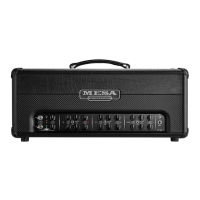
